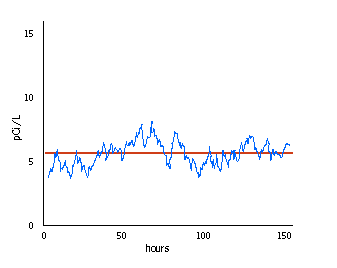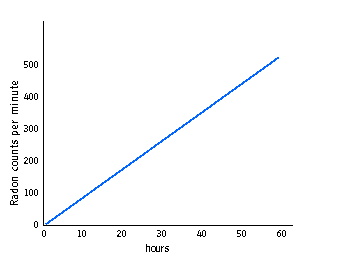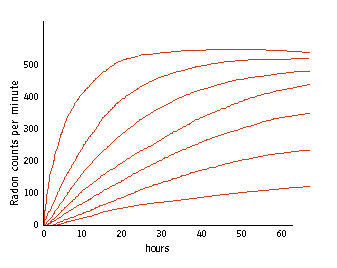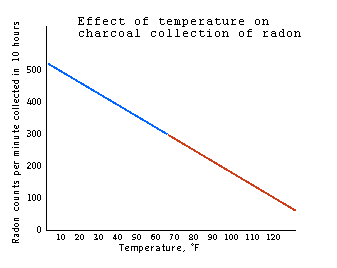Analytical Procedures and Comparisons
As appeared in "Indoor Air Review," 1990By Dr. J. L. Alvarez, Ph.D. Physics, Chief Scientific Consultant to Air Chek, Inc.
There are several techniques for monitoring for radon and several reasons for the various techniques. We will discuss these techniques and the reasons for using them, particularly the Air Chek, Inc. approach.
 The most meaningful statistic to be determined for radon is a person's
annual average radon exposure. This annual average is used to estimate
the health effects, the specific effect being lung cancer. Any statistic is
really an estimate. How good an estimate is determined by the measurement
technique, and how good an estimate must be is determined by the requirements
for the estimate. Since we are concerned with the annual average radon exposure,
we are concerned with length of sampling period, accuracy, and factors that
affect accuracy.
The most meaningful statistic to be determined for radon is a person's
annual average radon exposure. This annual average is used to estimate
the health effects, the specific effect being lung cancer. Any statistic is
really an estimate. How good an estimate is determined by the measurement
technique, and how good an estimate must be is determined by the requirements
for the estimate. Since we are concerned with the annual average radon exposure,
we are concerned with length of sampling period, accuracy, and factors that
affect accuracy.
The radon concentration varies continuously in a home, as Figure 1 shows. The figure shows hourly results over a seven-day period. The bold line shows the average for the seven days. The annual average may be very different, higher in winter and lower in summer, and may vary as much as a factor of three from any single daily average. These variations are the result of weather and ventilation of the house.
As was stated above, there are several methods for estimating the annual average. These vary in intent from screening measurements to definitive measurements and include continuous measurements (as in Figure 1); integrated, long-term (one year); integrated, short-term (one to three months); multiple, short-term; and single, one- to seven-day measurements. The latter are termed screening measurements and are by far the largest number of radon concentration measurements made and the only type measurements needed for the great majority of homes. Most homes have no radon and that can be determined with a single, properly executed screening measurement.

 The measurements are made by either continuously measuring the
radon, collecting radon and measuring it later, or collecting and storing the
radiation effects of the radon. All of these methods rely on measurement of the
radiation emitted by the radon. The radon concentrations are much too low to be
measured by any other physical means. A continuous measurement results in a
record much like that of Figure 1. Continuous collection of radon should
result in an ever-increasing amount of radon as shown in Figure 2.
The actual result is shown as one of the curves in Figure 3.
Because radon is undergoing radioactive decay and the collector is reaching
equilibrium, it will reach a maximum, dependent upon the collection device.
There is no need to collect radon beyond this maximum except for averaging. The
final technique, that of collecting radiation effects, is the altering of some
intrinsic and measurable property of the collecting material such that this
alteration can be related to the sum of radon exposed to the device. These
latter devices are usually confined to long-term measurements only.
The measurements are made by either continuously measuring the
radon, collecting radon and measuring it later, or collecting and storing the
radiation effects of the radon. All of these methods rely on measurement of the
radiation emitted by the radon. The radon concentrations are much too low to be
measured by any other physical means. A continuous measurement results in a
record much like that of Figure 1. Continuous collection of radon should
result in an ever-increasing amount of radon as shown in Figure 2.
The actual result is shown as one of the curves in Figure 3.
Because radon is undergoing radioactive decay and the collector is reaching
equilibrium, it will reach a maximum, dependent upon the collection device.
There is no need to collect radon beyond this maximum except for averaging. The
final technique, that of collecting radiation effects, is the altering of some
intrinsic and measurable property of the collecting material such that this
alteration can be related to the sum of radon exposed to the device. These
latter devices are usually confined to long-term measurements only.
CONTINUOUS MEASUREMENTS OF RADON
Continuous samplers are usually expensive, complicated, and require an experienced operator. They are fine and necessary for mitigation work, confirmation measurements, and specialized measurements in homes. They are hardly practical for screening measurements and are much too expensive for most homeowners. Radiation effects devices are either alpha track, TLD, or electrets. Alpha-tracks are plastics that show microscopic radiation tracks after chemical treatment. TLDs or thermoluminescent devices emit light when heated after exposure to radiation. Both these devices require at least a month's exposure to even moderate levels of radon. The last device, an electret, is a semi-permanently electrically charged material (usually a type of plastic insulator) that loses its charge in the presence of radiation. Their use requires a special reader and the use of calibration factors specific to each style or type of device. The user must be prepared to take very careful steps when placing, retrieving, and measuring electrets. Even the slightest mistake will usually result in a "false-high" being calculated because these devices may have lost their electrical charge unknowingly. These devices can be used for both short- and long-term exposures if the device is matched to the radon level.
COLLECTION OF RADON
The last method to consider is collection of radon. This method includes collection of a volume of air or collection on activated charcoal for analysis in a laboratory. Collection on charcoal is by far the most practical and gives an integrated collection up to its maximum. This is the type of collection depicted in Figure 3. Charcoal collection is the most popular radon measuring technique by a very large margin, because of its simplicity, low cost, and accuracy. It is almost always used as a screening technique, but multiple samples (as few as three), spaced over the year, will give a good estimate of the annual average.
The annual average can then be estimated by a short-term measurement, less than seven days, using a charcoal adsorber. This estimate, termed a screening measurement, is sufficient for most purposes. Its accuracy can be increased by multiple measurements at different locations during the same time period and by measuring several times during the year. The quantitative part of the measurement, the laboratory result, can be affected by the environmental conditions. These conditions are temperature, moving air streams, and humidity.
 The temperature effect is shown in Figure 4. There is nothing
to be done about it, except to note the temperature and account for its effect.
Moving air influences the sample in a variety of ways, depending upon the design
of the sampler. There are two ways to reduce the effects of moving air; avoid
moving air streams when placing the sampler and/or design the sampler to reduce
moving air effects. Air Chek, Inc. has successfully designed its sampler to
minimize moving air effects; however, very fast moving air should be avoided if
possible. The major environmental factor affecting the collection of radon by
charcoal is humidity.
The temperature effect is shown in Figure 4. There is nothing
to be done about it, except to note the temperature and account for its effect.
Moving air influences the sample in a variety of ways, depending upon the design
of the sampler. There are two ways to reduce the effects of moving air; avoid
moving air streams when placing the sampler and/or design the sampler to reduce
moving air effects. Air Chek, Inc. has successfully designed its sampler to
minimize moving air effects; however, very fast moving air should be avoided if
possible. The major environmental factor affecting the collection of radon by
charcoal is humidity.
 Figure 5 shows the adsorption of radon on charcoal at 75
percent relative humidity. The left-hand vertical scale shows the adsorption of
radon in radioactive units while the right scale shows the moisture adsorption
in percent weight change of the charcoal. It is obvious that the adsorption
capacity of charcoal for radon decreases with increasing moisture adsorption. A
technique for minimizing the moisture effect is to include a diffusion barrier
before the charcoal. This will slow the absorption of both radon and water (and
decrease the maximum amount of radon collected), thereby extending the
collection, or averaging, period of the radon and increasing the accuracy of the
estimate. This diffusion barrier effect is shown in Figure 6. Air Chek,
Inc. has chosen to incorporate both a diffusion barrier and a series of
calibration curves to minimize the humidity effects while maximizing the radon
collected. The series of curves is as shown in Figure 7.
Figure 5 shows the adsorption of radon on charcoal at 75
percent relative humidity. The left-hand vertical scale shows the adsorption of
radon in radioactive units while the right scale shows the moisture adsorption
in percent weight change of the charcoal. It is obvious that the adsorption
capacity of charcoal for radon decreases with increasing moisture adsorption. A
technique for minimizing the moisture effect is to include a diffusion barrier
before the charcoal. This will slow the absorption of both radon and water (and
decrease the maximum amount of radon collected), thereby extending the
collection, or averaging, period of the radon and increasing the accuracy of the
estimate. This diffusion barrier effect is shown in Figure 6. Air Chek,
Inc. has chosen to incorporate both a diffusion barrier and a series of
calibration curves to minimize the humidity effects while maximizing the radon
collected. The series of curves is as shown in Figure 7.
 Some others have chosen to either incorporate extreme diffusion
barriers and assume the problem has gone away or to estimate the possible
moisture adsorbed for the time of the year and use a median calibration curve.
Air Chek, Inc.’s research staff has found that neither of these approaches is
acceptable to the accuracy limits to which Air Chek, Inc. is committed. We,
therefore, automatically measure the moisture on all samples and apply a full
set of moisture calibration curves.
Some others have chosen to either incorporate extreme diffusion
barriers and assume the problem has gone away or to estimate the possible
moisture adsorbed for the time of the year and use a median calibration curve.
Air Chek, Inc.’s research staff has found that neither of these approaches is
acceptable to the accuracy limits to which Air Chek, Inc. is committed. We,
therefore, automatically measure the moisture on all samples and apply a full
set of moisture calibration curves.
We have discussed the environmental effects on the sampler. The objective of the sampler and the minimizing of environmental effects is to maximize the amount of radon collected. The amount of radon collected is directly related to the accuracy of the final measurement. The accuracy is a statistical function of the total radon, the time of counting, the efficiency of the counting system, the background of the counting system, and the variation of the background. The background and the counting efficiency also determine the minimal detectable activity. The Air Chek, Inc. approach is to provide the most accurate and efficient system possible.
MEASUREMENT OF COLLECTED RADON
The usual method for measuring radon is detection of the gamma rays produced by the daughters of radon by scintillation counting using sodium iodide detectors. This is the method used by Air Chek, Inc. Sodium iodide detectors are very efficient for the detection of gamma rays so that they have a very high background from naturally occurring radiation. The difference between the average background and total sample counts is the net or actual sample counts. Since the background is a statistically varying number the average is only an estimate of the background at any one time. Air Chek, Inc. uses heavily shielded detectors (over 14,000 pounds of lead) so that the average background and its variation are at a minimum, thereby maximizing accuracy.
 The largest difference between background and total sample can additionally
be obtained by increasing the amount of radon on the sample, a design feature of
the Air Chek, Inc. packet, and increasing the detection efficiency of the
detectors. Figure 6 shows the maximizing of radon collection with Air
Chek, Inc. packets. Figure 3's lower curve shows the collection
efficiency of an extreme diffusion barrier. This same system when placed on a
sodium iodide detector has a less than 45 percent counting efficiency, as shown
in Figure 6. A similar problem is encountered with the original EPA-type
canister, which has an even lower counting efficiency when measured on a
standard three inch unit. The original EPA canister does not incorporate a
diffusion barrier and may adsorb much more radon, because it is larger, under
dry collection conditions. However its collection characteristics are
disturbed when exposed to high humidity or air movement. The Air Chek, Inc.
approach is to use very high efficiency detection as, Figure 9 shows. The
combination of very low background, high sample collection, and high counting
efficiency gives Air Chek, Inc. accuracy and sensitivity not matched by any
other system. The lower limit of detection for the Air Chek, Inc. system, at
one-half life, is 0.2 pCi/l for dry conditions and 0.5 pCi/l for very humid
conditions. Accuracy is respectively +/-5 percent and may extend to +/-20
percent for very damp samples. Air Chek, Inc. recommends a retest when the
accuracy drops to +/-20 percent. (EPA RMP qualification is set at +/-25 percent
accuracy.)
The largest difference between background and total sample can additionally
be obtained by increasing the amount of radon on the sample, a design feature of
the Air Chek, Inc. packet, and increasing the detection efficiency of the
detectors. Figure 6 shows the maximizing of radon collection with Air
Chek, Inc. packets. Figure 3's lower curve shows the collection
efficiency of an extreme diffusion barrier. This same system when placed on a
sodium iodide detector has a less than 45 percent counting efficiency, as shown
in Figure 6. A similar problem is encountered with the original EPA-type
canister, which has an even lower counting efficiency when measured on a
standard three inch unit. The original EPA canister does not incorporate a
diffusion barrier and may adsorb much more radon, because it is larger, under
dry collection conditions. However its collection characteristics are
disturbed when exposed to high humidity or air movement. The Air Chek, Inc.
approach is to use very high efficiency detection as, Figure 9 shows. The
combination of very low background, high sample collection, and high counting
efficiency gives Air Chek, Inc. accuracy and sensitivity not matched by any
other system. The lower limit of detection for the Air Chek, Inc. system, at
one-half life, is 0.2 pCi/l for dry conditions and 0.5 pCi/l for very humid
conditions. Accuracy is respectively +/-5 percent and may extend to +/-20
percent for very damp samples. Air Chek, Inc. recommends a retest when the
accuracy drops to +/-20 percent. (EPA RMP qualification is set at +/-25 percent
accuracy.)
 There is one other approach to radon collection and counting that has a
reduced moisture problem, a high counting efficiency, but low collection
efficiency. This approach is liquid scintillation counting of a very small
volume of charcoal which is exposed through a low pass diffusion barrier. In
some designs there is a desiccant included to reduce adsorbed moisture. Two such
systems are shown in Figure 10.
The very large increase in counting
efficiency obtained by liquid scintillation counting (alphas, betas, and gamma's
are counted) allow these systems to approach Air Chek’s method in sensitivity.
They have, however, a major inherent problem that may never be solved. This is
caused from the slightly varying amounts of charcoal in each sample's enclosed
capsule which is filled based on volume. These capsules were designed to remove
odors from foul smelling medicines and vitamins where their exact weight is not
a requirement. When one is analyzing the amount of radon collected per sample,
one must know how much charcoal is in each sample, by its weight not by its
volume.
There is one other approach to radon collection and counting that has a
reduced moisture problem, a high counting efficiency, but low collection
efficiency. This approach is liquid scintillation counting of a very small
volume of charcoal which is exposed through a low pass diffusion barrier. In
some designs there is a desiccant included to reduce adsorbed moisture. Two such
systems are shown in Figure 10.
The very large increase in counting
efficiency obtained by liquid scintillation counting (alphas, betas, and gamma's
are counted) allow these systems to approach Air Chek’s method in sensitivity.
They have, however, a major inherent problem that may never be solved. This is
caused from the slightly varying amounts of charcoal in each sample's enclosed
capsule which is filled based on volume. These capsules were designed to remove
odors from foul smelling medicines and vitamins where their exact weight is not
a requirement. When one is analyzing the amount of radon collected per sample,
one must know how much charcoal is in each sample, by its weight not by its
volume.
At Air Chek, Inc. the known dry weight of each sample is measured to one-tenth of a gram. This amount of potential variation (+/- one-half of one-tenth of a gram) will cause the result to vary only +/-0.3%. (That is less than one-half of one percent.) Because ALL analysis calculations are based on the known collection efficiency of the charcoal in "counts per unit of charcoal" one must know how many units are being counted. When using such a small amount of charcoal as is used by the liquid scintillation methods, just one-tenth of a gram will throw the result off by as much as +/-20%. This is reflected in the reports from the USEPA's RMP program, showing many failures by the organizations who use this method.
 Additionally, liquid scintillation analysis systems are more expensive to
operate because they require special preprocessing procedures, longer counting
times, and the scintillate is a hazardous waste which must be disposed of
properly. The automatic counters currently available can accommodate only 400
samples per 24 hour period compared to Air Chek's system which can easily handle
up to 5000 samples per 24 hours.
Additionally, liquid scintillation analysis systems are more expensive to
operate because they require special preprocessing procedures, longer counting
times, and the scintillate is a hazardous waste which must be disposed of
properly. The automatic counters currently available can accommodate only 400
samples per 24 hour period compared to Air Chek's system which can easily handle
up to 5000 samples per 24 hours.
We have now discussed the major aspects of radon counting and the Air Chek, Inc. approach. Before we conclude we would like to mention open land measurements. In many instances, these are being required or requested before building. To date there is no good correlation between open land testing and radon concentrations in homes, only a potential for predicting possible levels and building to minimize later problems. Air Chek, Inc. offers an open land kit as shown in Figure 11. The system is best deployed above a post hole about three feet deep.
SYNOPSIS
We conclude with a synopsis of the major topics. The important estimate for radon health effects is the annual average radon concentration. The length of the sampling time to arrive at an estimate is dependent upon the aims of the estimate, but for most purposes and especially for screening, less than seven days is sufficient. Environmental factors can greatly affect the radon measurement, so the temperature of the collecting site and the relative humidity should be known. High relative humidity suggests that the test should be shortened to reduce loss of sample. Areas of high ventilation rates should be avoided to reduce air movement effects. Final accuracy depends upon the sampling methods and the detection system in the laboratory. Air Chek, Inc. has developed a sampling system that maximizes sample collection while minimizing environmental effects and has developed a highly efficient and accurate counting system that corrects for moisture and temperature effects. Air Chek, Inc. maintains strict quality control on the manufacture of its samplers, and the calibration, maintenance and laboratory procedures of its counting laboratory.